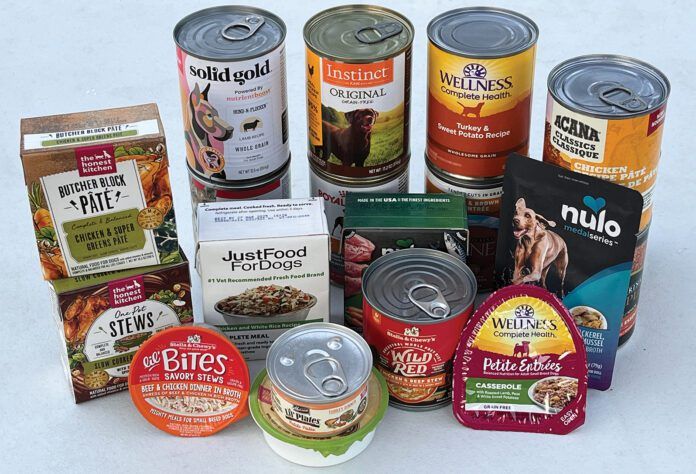
There are many reasons people feed canned food to their dogs (we will get into those in a minute) and one main reason why more people do not feed canned: The price of canned food—especially the best canned foods—is prohibitively expensive for many of us, unless, perhaps, you’re feeding just one small dog.
But let’s go back to the reasons to feed canned food—reasons that may justify the cost for owners of certain dogs:
- With at least 75% moisture, and as much as 85% or more, canned dog food is one of the best possible ways to make sure that a dog with kidney and other urinary tract issues consumes enough moisture. Dogs who are prone to dehydration or who are given diuretic medications benefit from a high-moisture diet.
- Canned foods are generally very low in carbohydrates, or contain zero carbohydrates. (Remember, dogs have zero nutritional requirement for carbs. They can obtain all of their nutritional needs from protein and fat sources.) This is most helpful when feeding dogs who have cancer. (Tumors use carbohydrates as an energy source, so you want your cancer-patient dog to consume as few carbs as possible.)
- The vast majority of canned foods are made with fresh (or fresh-frozen) meats instead of meat meal, which has been highly processed before its potential inclusion into a secondary food-production process. Overall, the ingredients in canned foods are subjected to much less processing than those in dry foods.
- Canned foods are more digestible than kibble, meaning, your dog will absorb more nutrients in the food. This helps dogs who have sensitive stomachs or other digestive issues.
- With their high meat content, canned foods are extremely palatable to most dogs, without the addition of sweeteners or other palatants. This, and the physical properties of loaf-style canned food (spoonable, spreadable, freezable), make it highly convenient for use in behavior-change or -maintenance applications (filling Kong or Toppl toys, lick mats, and other time-consuming food puzzles). Other people “top” their dog’s kibble with a bit of canned food, whether to help entice picky eaters or to just give their dogs something more delicious than kibble.
Best Canned Dog Food by Category
With all of these compelling reasons to feed canned, why don’t you? If the burden of having to choose an appropriate product from the overwhelming number of canned dog foods that are on the market is holding you back, maybe we can help!
Using the criteria we’ve always used to select and highlight foods (which you can view below) we’ve chosen at least three products to recommend in eight different categories, which, in turn, were chosen to highlight attributes that different dog owners might have foremost in mind for meeting their dogs’ needs. The categories are:
- Best Canned Foods for Adult Dog Maintenance
- Best “All Life Stages” / Growth Canned Dog Food
- Best Limited Ingredient Canned Dog Foods
- Best Budget Canned Dog Foods
- Best High Protein Canned Dog Foods
- Best Lower-Fat Canned Dog Foods
- Best Grain-Free Canned Dog Foods
- Best Canned Dog Foods Containing Alternative Protein
Some dogs need only an adult-maintenance diet, which generally contain lower amounts of fat and protein (and a few other nutrients) than puppies do, whereas growing puppies, pregnant or nursing moms, and highly active dogs need an “all life stages” food. (Remember, the nutrient requirements for growth [i.e., “puppy food”] and foods for “all life stages” are the same.)
Beyond those two basic categories, your dog might have specific needs for a limited-ingredient or grain-free diet, or one with lower amounts of fat or higher amounts of protein. Some human needs and priorities have been considered, too: Some owners feel strongly about feeding a diet that does not contain animals, and still others might have budgetary limitations; we have selections to meet those criteria, too!
In order to choose our favorites in each of these categories, and in addition to our usual selection criteria having to do with the candidates’ ingredients, we considered our own experiences with the companies. Have they invited us or allowed us to personally tour their production facilities or speak to their formulators?
We also took into account the companies’ demonstrated willingness to disclose to us their manufacturing location or locations and the qualifications of the person or people who formulated the companies’ products, and to provide us with technical information about their products, such as complete nutrient analyses and the results from any digestibility studies they’ve conducted.
Of course, it’s great if you don’t even have to ask for this information. Companies that publish complete nutrient analyses for their products on their websites will always get more consideration from us. Why every dog food maker doesn’t do this is beyond our comprehension.
Here are our top picks in canned dog food:
Best Adult Maintenance Canned Dog Food
Rawz 96% Chicken & Chicken Liver Dog Food
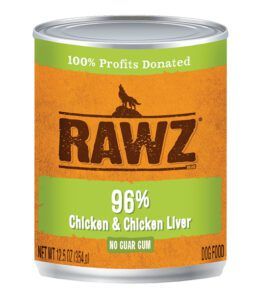
Things we like:
- Clean, simple recipe; essentially just chicken and chicken liver (plus a vitamin/mineral mix)—and no carbs
- Expanded nutrient analysis available on company website
- Fenugreek seeds used as thickener instead of gums
First 10 ingredients: Chicken, chicken liver, chicken broth, fenugreek seed, potassium chloride, calcium carbonate, tricalcium phosphate, choline chloride, salt, taurine
- Protein: Min 11%
- Fat: 9%
- Calories: 446 Kcal/12.5-oz can
- Cost: $0.39/oz
Runners up:
- Nulo Gently Cooked Meals Turkey & Green Beans Recipe
- Open Farm Chicken & Salmon Recipe
Best “All Life Stages” / Growth Canned Dog Food
The Honest Kitchen’s Butcher Block Turkey & Autumn Veggies Pâté
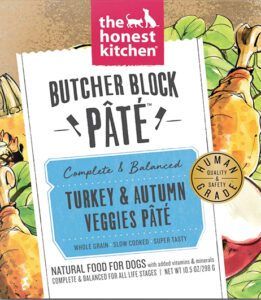
Things we like:
- Only human-grade ingredients are used and product is made in a human-food manufacturing facility
- Single-species source of animal protein
- Loaf style food easiest to use in time-consuming, enrichment toys such as lick mats, Toppls, and Kongs
First 10 ingredients: Turkey, turkey bone broth, turkey liver, spinach, apples, carrots, brown rice, pumpkin, agar agar, minerals
- Protein: Min 10.5%
- Fat: 5.5%
- Calories: 366 Kcal/10.5-oz box
- Cost: $0.40/oz
Runners up:
- Bixbi Rawbble Turkey Recipe for Puppies
- Lucy Kettle Creations Chicken & Salmon in Gravy
Best “Limited Ingredient” Canned Dog Food
Dave’s 95% Premium Meats Chicken & Beef
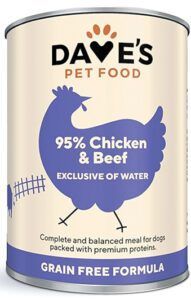
Things we like:
- Very limited-ingredient: Two animal species and zero carb sources
- “All life stages” food
- Moderately priced
First 10 ingredients: Chicken, beef, beef broth, chicken liver, agar agar, dicalcium phosphate, calcium carbonate, salt, flaxseed, potassium chloride
- Protein: Min 9%
- Fat: 7.5%
- Calories: 354 Kcal/13.5-oz can
- Cost: $0.28/oz
Runners up:
- FirstMate Limited Ingredient Cage-Free Chicken Formula
- Essence LIR Ocean Recipe
- American Journey Limited Ingredient Diet Duck Recipe
- Instinct Limited Ingredient Diet Real Rabbit Recipe
Best Budget Canned Dog Food
Purina Beyond Beef, Potato, & Green Bean Ground Entrée
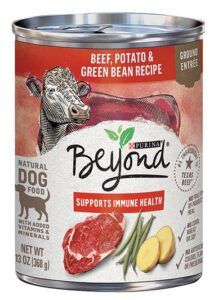
Things we like:
- Very simple formula
- Inexpensive without using meatby-products or food fractions
- Pâté style
First 10 ingredients: Beef, beef broth, chicken, liver, potatoes, green beans, guar gum, salt, minerals
- Protein: Min 8%
- Fat: 6%
- Calories: 450 Kcal/13-oz can
- Cost: $0.14/oz
Runners up:
- Inception Chicken & Pork Recipe ($0.20/oz)
- Chicken Soup for the Soul Classic Chicken, Brown Rice & Vegetables Recipe ($0.19/oz)
- Fromm Adult Turkey & Rice Pâté ($0.19/oz)
Best High Protein Canned Dog Food
The Honest Kitchen’s Beef, Lamb, & Spring Veggies
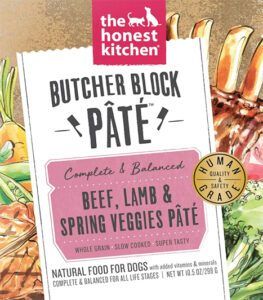
Things we like:
- The food boasts high protein without a crazy-high fat content
- Food is made with all human-grade ingredients in a human-food facility
- Complete nutrient analysis available on company website
First 10 ingredients: Beef, beef bone broth, beef liver, lamb, carrots, broccoli, peas, agar-agar, quinoa, sunflower oil
- Protein: Min 12.5%
- Fat: 5%
- Calories: 298 Kcal/10.5-oz box
- Cost: $0.40/oz
Runners up:
- From Chicken & Rice Pâté (10% protein)
- Natural Balance Platefulls Tender Carrot, Potato & Beef Recipe (10.5% protein)
Best Lower-Fat Canned Dog Food
Stella & Chewy’s Stella’s Stew Cage-Free Medley
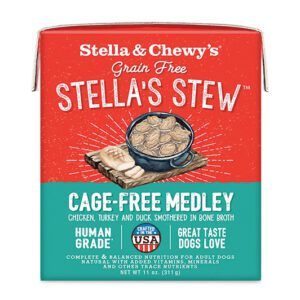
Things we like:
- Made with human-grade ingredients in a human-food facility
- Fat is low but protein is still high
- Simple, meat-rich formula, no legumes
First 10 ingredients: Cage-free chicken, chicken bone broth, cage-free turkey, tapioca starch, cage-free duck, tricalcium phosphate, calcium carbonate, potato starch, salt, potassium chloride
- Protein: Min 10%
- Fat: 2%
- Calories: 243 Kcal/11-oz carton
- Cost: $0.36/oz
Runners up:
- Blackwood Chicken & Chicken Liver With Pumpkin & New Zealand Mussels (Min 1.5% fat)
- Hound & Gatos Pork & Liver Recipe (Min 3.5% fat)
Best Grain-Free Canned Dog Food
Caru Classics Turkey With Lamb Stew
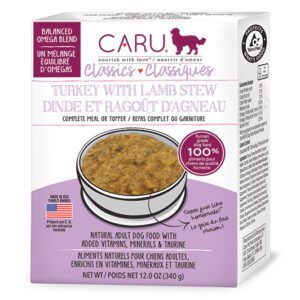
Things we like:
- No reliance on (and typical over-representation of) legumes to replace grain
- Amount of taurine on the guaranteed analysis
- Food is made with 100% human grade ingredients
- Moderate protein and fat levels
First 10 ingredients: Turkey, turkey bone broth, pumpkin, apples, carrots, sweet potatoes, green beans, lamb, tapioca starch, lentils
- Protein: Min 5%
- Fat: 2%
- Calories: 258 Kcal/12-oz carton
- Cost: $0.42/oz
Runners up:
- Wellness Complete Duck & Sweet Potato
- Instinct Original Real Chicken Recipe
- Nulo’s Small Breed Pâté for Puppy
Best Canned Dog Food Containing Alternative Proteins
Health Extension Vegetarian Entrée
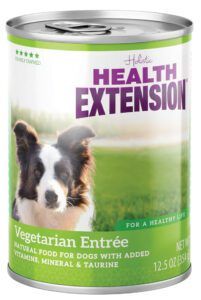
Note: The advantage of canned dog food is its ability to provide a food with a high meat inclusion in a long-lasting, shelf-stable container. But for those who want to feed a canned diet, and don’t want to or can’t give their dog meat, here you go!
- We prefer non-legume carb sources; our top pick contains only one legume.
- Of the canned vegetarian foods we found, this has the most protein at 7%
First 10 ingredients: Sweet potatoes, butternut squash, water sufficient for processing, brown rice, carrots, olive oil, peas, blueberries, cranberries, kale
- Protein: Min 7%
- Fat: 2%
- Calories: 276 Kcal/can
- Cost: $0.30/oz
Runners up:
- Halo Holistic Adult Dog Garden of Vegan Recipe
- Natural Balance Vegetarian Recipe
Here’s the criteria we use to choose the products that we include on our “Approved Canned Foods” list, as well as our selections for the overall “Best” canned foods.
Top-quality canned dog foods exhibit these hallmarks of quality:
- Named animal protein sources at the top of the ingredients list. Ingredients in pet food are listed in order of the weight of that ingredient in the formula, so you want to see a named animal protein source or sources in at least one of the top two spots on the list of ingredients. (“Named” means the species is identified: chicken, beef, lamb, etc.)
- Water or broth may be first or second on the list, as the addition of water is often necessary for processing. But the animal protein source or sources should appear immediately after that.
- If plant proteins are present in the food, we like to see them play a supporting role, appearing lower on the ingredient list – no earlier than the fifth or sixth position. The amino acid profiles offered by animal proteins suit dogs better than those of peas, potatoes, corn, soy, etc.
- Named fat sources. Just as with the animal protein sources, any animal fat sources should be identified by species (i.e., chicken fat, beef fat, pork fat, etc.).
- Whole foods. When vegetables, fruits, grains, and/or other carbohydrate sources such as chickpeas, peas, or sweet potatoes are used, to the extent possible, they should be whole.
- Ingredients that have already been processed, shipped, and stored before they are mixed with other ingredients and processed again (canned) lose more of their nutritive value along the way than those that are shipped and stored whole before their inclusion into the wet food mix.
- Ingredients that are certified as organic, humanely raised, or sustainably farmed. Companies will use wiggle words to lend the impression that they are using the best ingredients available. Certifications give these claims credibility.
Here are the things we look out for – undesirable attributes that indicate a lower-quality food:
- Animal products that are not specified by species. Meat, meat meal, poultry, poultry meal, animal fat, poultry fat: If your dog is intolerant of or allergic to certain ingredients, you have to know what you’re feeding him.
- Animal by-products. This includes meat by-products and poultry by-product. We would strongly prefer to know what, exactly, is being included in the food, instead of “by-products” being used as a catch-all term for whatever. In some cases, the “by-products” used may well be nutritious chicken liver, chicken kidneys, and chicken hearts – well, say that then!
- Ingredient splitting. This is where two or more very similar food “fractions” appear on the ingredients list. Because the ingredients are listed in descending order of their weight, a manufacturer can make it appear that a high-quality ingredient is represented in the food in a greater amount than it is. If all the iterations of an ingredient (to use a common example, brown rice, white rice, brewers rice) were combined or reconstituted, they would outweigh and push the higher-quality ingredient down on the ingredients list.
- Added sweeteners. Sweeteners are sometimes used in low-quality foods to increase their palatability. In canned foods, the protein- and fat-rich meaty ingredients should be enough to tempt the appetite of any dog. If sweeteners are needed in a canned food, we’d be highly suspicious.
- Artificial colors, flavors, or preservatives. None of these are needed (or common, thankfully) in canned food.
Each of the canned dog foods we have included in our “Best Canned Dog Food” selections, and all of the foods on our “Approved Canned Dog Foods” list, meet our selection criteria for top-quality canned foods (described above) – but we’ve also included some softer criteria in our choices for these “Best” selections, including:
- Past experience with the company. (Have they been, in our experience, easy to reach and quick to respond to questions? Have they invited us or allowed us to personally tour their production facilities or speak to their formulators?)
- A company’s demonstrated willingness to provide its location, qualifications of the person/people who formulated the company’s products, complete nutrient analyses, digestibility studies, and other technical information about its products. (The more of this information that’s on a company’s website, the more brownie points they get from us.)
- Past performance of the company (i.e., few or no serious recalls).
Use Our Canned Dog Food Search Tools
With your dog’s specific needs in mind, we recommend searching among the pet food companies on our list of “Approved Canned Foods” (available to WDJ subscribers only). We’d also like to recommend using the tool to search our list of more than 800 individual foods and add as many filters as you want to find the most appropriate candidates for your dog. Looking for a higher-protein, lower-fat food without chicken or peas? Add the filters and search!
And don’t forget: One-size-fits-all recommendations don’t work when it comes to diet. Feed each of your dogs what works best for him. It’s great when you have more than one dog and they can thrive on the same variety of food, but don’t take this for granted.
(Note: Affiliate links are offered for your convenience. Whole Dog Journal is reader-supported. If you purchase food through links on our site we may earn a commission. Whole Dog Journal does not accept money for its food and product reviews.)






I don’t know how you missed “Weruva”. It’s great and most formulas smell like human food. I have show dogs and am a preservation breeder that breeds responsibly and rarely. Many pregnant girls become picky eaters at times during pregnancy and this is one can food that worked. I use it as a topper. They sell it at Chuck and Don’s and almost every good boutique dog food store in Colorado
I have a female Australian Labradoodle and she’s a picky eater. I’ve been switching foods but feel that’s not good. She’s 2 1/2 yo and quite healthy.
What do you suggest I feed her?
Should there be any concern that the Purina Beyond Organic canned dog food has carrageenan in it?
I feed my oldie goldie Stella and Chewy’s Digestive support and Weruva canned food. I always thought weruva was a good food and have been using it for many years. Is there a problem with it?